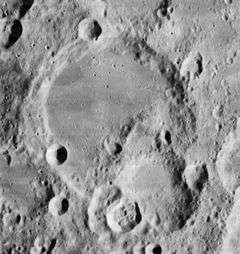Faraday (crater)
|
Lunar Orbiter 4 image of Stöfler with Faraday on the southeast rim | |
| Coordinates | 42°24′S 8°42′E / 42.4°S 8.7°ECoordinates: 42°24′S 8°42′E / 42.4°S 8.7°E |
|---|---|
| Diameter | 70 km |
| Depth | 4.1 km |
| Colongitude | 352° at sunrise |
| Eponym | Michael Faraday |
Faraday is a lunar impact crater in the southern highlands of the Moon. It lies across the southeast rim of the larger crater Stöfler, and the northwest rim of Faraday forms a wide rampart across the otherwise flat floor of Stöfler. To the west of Faraday is Maurolycus.
The rim of Faraday has been significantly overlain by subsequent impacts, most notably by an overlapping pair across the southwest rim and a crater across the northwest rim. There is a low central ridge running from the southwest to the northeast, nearly dividing the crater floor in half. The floor is nearly flat in the northwest half.
Satellite craters
By convention these features are identified on lunar maps by placing the letter on the side of the crater midpoint that is closest to Faraday.
| Faraday | Latitude | Longitude | Diameter |
|---|---|---|---|
| A | 41.5° S | 9.7° E | 21 km |
| C | 43.3° S | 8.1° E | 30 km |
| D | 43.7° S | 9.6° E | 14 km |
| G | 45.8° S | 10.1° E | 31 km |
| H | 45.0° S | 10.3° E | 12 km |
Due to its ray system, Faraday C is mapped as part of the Copernican System.[1]
References
- ↑ The geologic history of the Moon, 1987, Wilhelms, Don E.; with sections by McCauley, John F.; Trask, Newell J. USGS Professional Paper: 1348. Plate 11: Copernican System (online)
- Andersson, L. E.; Whitaker, E. A. (1982). NASA Catalogue of Lunar Nomenclature. NASA RP-1097.
- Blue, Jennifer (July 25, 2007). "Gazetteer of Planetary Nomenclature". USGS. Retrieved 2007-08-05.
- Bussey, B.; Spudis, P. (2004). The Clementine Atlas of the Moon. New York: Cambridge University Press. ISBN 978-0-521-81528-4.
- Cocks, Elijah E.; Cocks, Josiah C. (1995). Who's Who on the Moon: A Biographical Dictionary of Lunar Nomenclature. Tudor Publishers. ISBN 978-0-936389-27-1.
- McDowell, Jonathan (July 15, 2007). "Lunar Nomenclature". Jonathan's Space Report. Retrieved 2007-10-24.
- Menzel, D. H.; Minnaert, M.; Levin, B.; Dollfus, A.; Bell, B. (1971). "Report on Lunar Nomenclature by the Working Group of Commission 17 of the IAU". Space Science Reviews. 12 (2): 136–186. Bibcode:1971SSRv...12..136M. doi:10.1007/BF00171763.
- Moore, Patrick (2001). On the Moon. Sterling Publishing Co. ISBN 978-0-304-35469-6.
- Price, Fred W. (1988). The Moon Observer's Handbook. Cambridge University Press. ISBN 978-0-521-33500-3.
- Rükl, Antonín (1990). Atlas of the Moon. Kalmbach Books. ISBN 978-0-913135-17-4.
- Webb, Rev. T. W. (1962). Celestial Objects for Common Telescopes (6th revised ed.). Dover. ISBN 978-0-486-20917-3.
- Whitaker, Ewen A. (1999). Mapping and Naming the Moon. Cambridge University Press. ISBN 978-0-521-62248-6.
- Wlasuk, Peter T. (2000). Observing the Moon. Springer. ISBN 978-1-85233-193-1.
